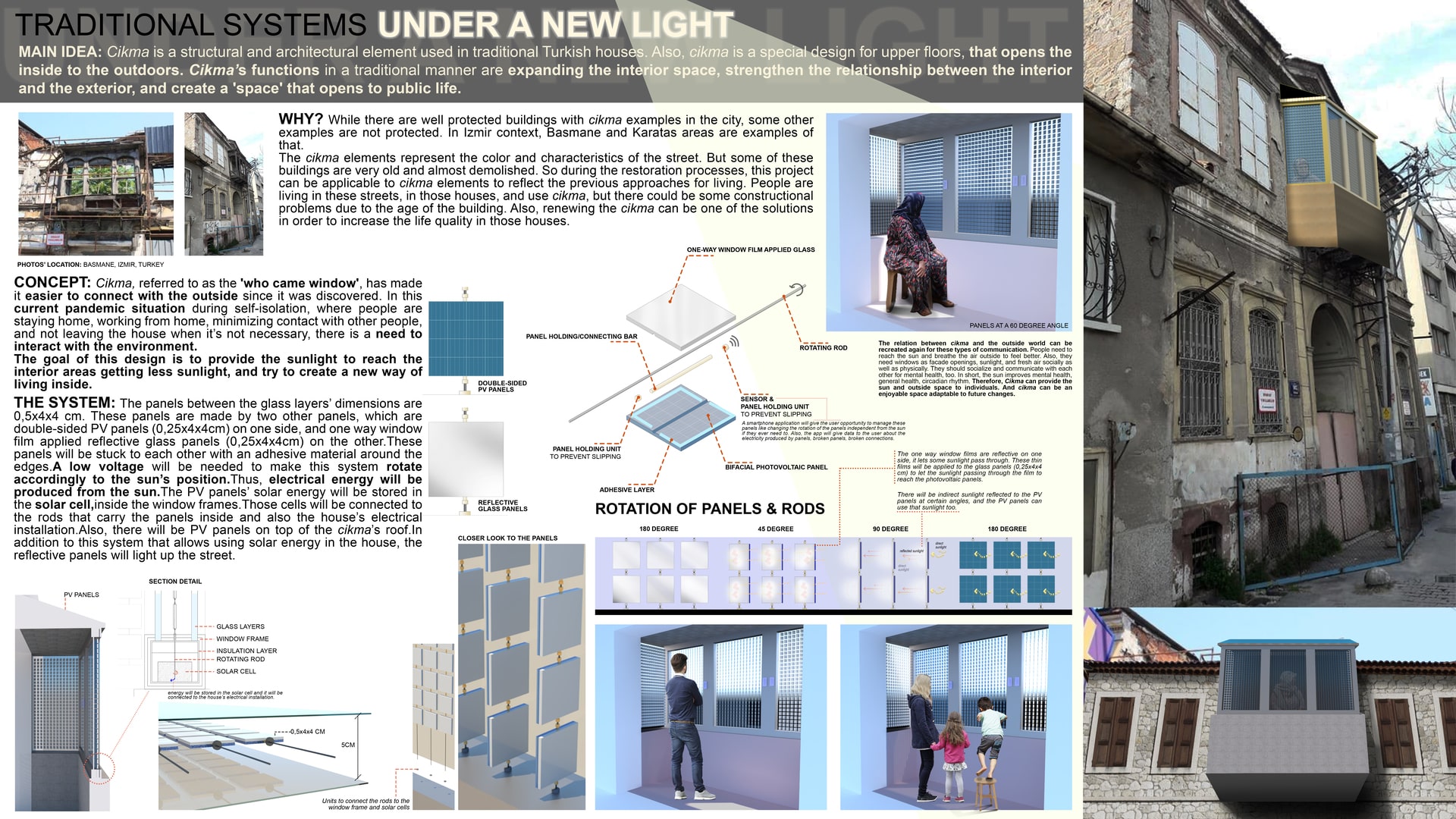Project Description
The Concept: When you look in traditional Turkish houses closely, you can see some touches from the Ottoman period. The architectural techniques, building elements, and materials are different from today’s modern methods. Currently, some traditional streets and neighborhoods where consist of row houses, can be found in the middle of the cities, in the center of attraction, in the center of tourist routes, etc. Besides, there are new buildings around those houses built with new techniques and perspectives, but some of them choose to protect the concept of the traditional elements. With this project, one of the most remarkable traditional elements, cikma, will be analyzed and be evolved. Cikma will be modernized by the technologies used in the consuming and conducting daylight aspect by increasing the usage potential of daylight. Cikma is a structural and architectural element used in traditional Turkish houses. Also, cikma is a special design for upper floors, that opens the inside to the outdoors. Cikma’s functions in a traditional manner are expanding the interior space, strengthen the relationship between the interior and the exterior, and create a 'space' that opens public life. Cikma, referred to as the 'who came window', has made it easier to connect with the outside since it was discovered. In this current pandemic situation during self-isolation, where people are staying home, working from home, minimizing contact with other people, and not leaving the house when it’s not necessary, there is a need to interact with the environment. The relation between cikma and the outside world can be recreated again for these types of communication. People need to reach the sun and breathe the air outside, to feel better. Also, they need windows as facade openings, sunlight, and fresh air socially as well as physically. They should socialize and communicate with each other for mental health, too. In short, the sun improves mental health, general health, circadian rhythm. Therefore, cikma can provide the sun and outside space to individuals. And cikma can be an enjoyable space adaptable to future changes. While there are well protected buildings with cikma examples in the city, there are some other examples that are not protected. In Izmir context, Basmane and Karatas areas are examples of that. The cikma elements represent the color and characteristics of the street. But some of these buildings are very old and almost demolished. So during the restoration processes, this project can be applicable to cikma elements to reflect the previous approaches for living. People are living in these streets, in those houses, and use cikma, but there could be some constructional problems due to the age of the building. Also, renewing the cikma can be one of the solutions in order to increase the life quality in those houses. The System: The panels used in between the glass layers’ height and width are 4cm and its thickness is 0,5cm. These panels are made by two other panels, which are double-sided/bifacial photovoltaic panels (0,25x4x4 cm) on one side, and one way window film applied reflective glass panels (0,25x4x4 cm) on the other side. The one way window films are reflective on one side, it lets some sunlight pass through. These thin films will be applied to the glass panels (0,25x4x4 cm) to let the sunlight passing through the film to reach the photovoltaic panels. These panels will be stuck to each other with an adhesive material around the edges. The goal of this design is to provide the sunlight to reach the interior areas getting less sunlight, and try to create a new way of living inside. A low voltage will be needed to make this system rotate accordingly to the sun’s position. Thus, electrical energy will be produced from the sun. The photovoltaic panels’ stored solar energy will be in the solar cell, inside the window frames. Those cells will be connected to the rods that carry the panels inside the glass layers and also the house’s electrical installation. Also, there will be photovoltaic panels on top of the cikma’s roof. In addition to this system that allows us to use solar energy in the house, the reflective panels will light up the street. The piece that connects the panels onto the rotating rod will have sensors in order to connect the user to the system. A smartphone application will give the user opportunity to manage these panels like changing the rotation of the panels independent from the sun if they ever need to. Also, the app will give data to the user about the electricity produced by panels, broken panels, broken connections.
